
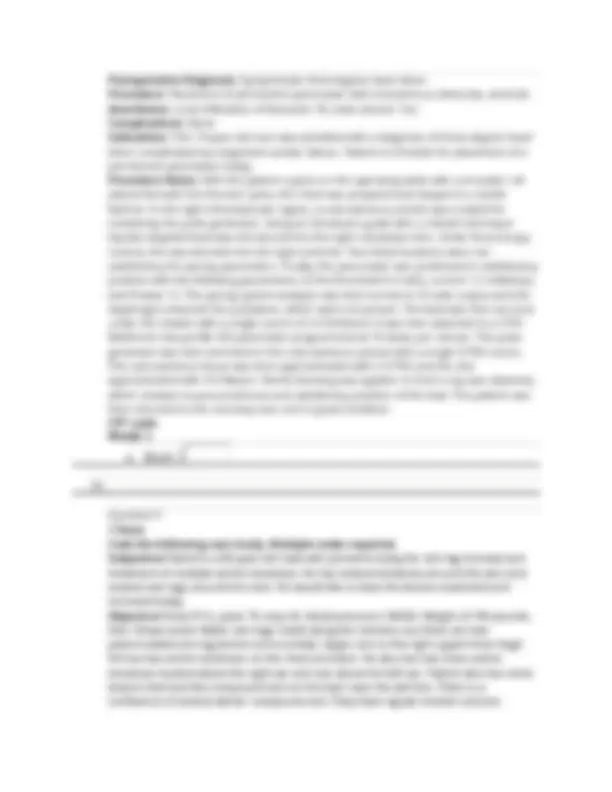
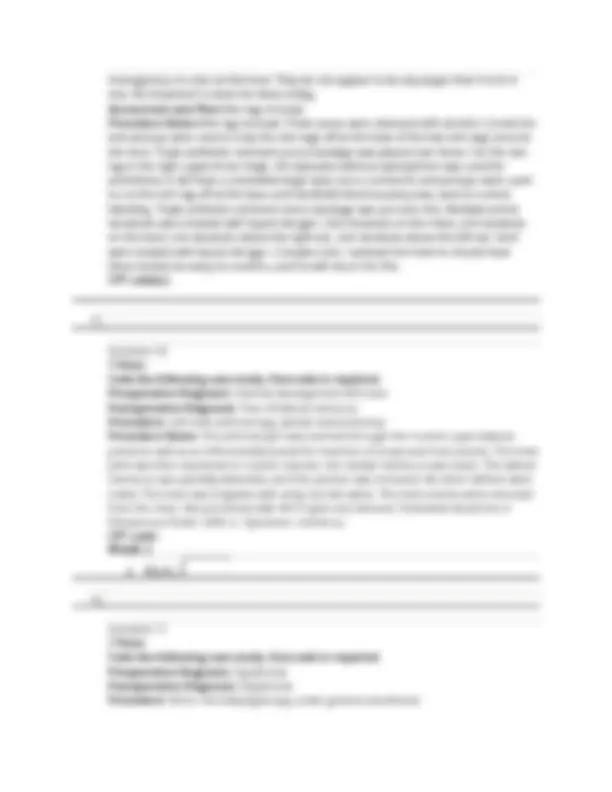
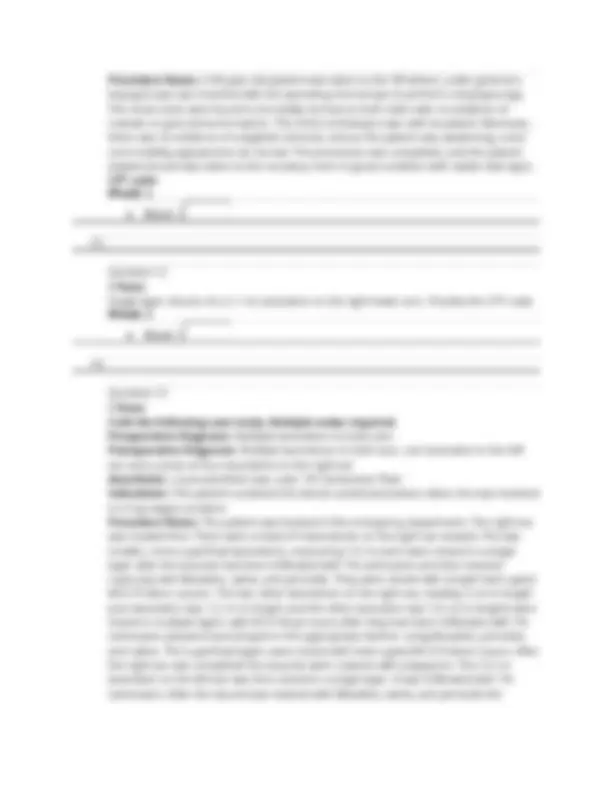
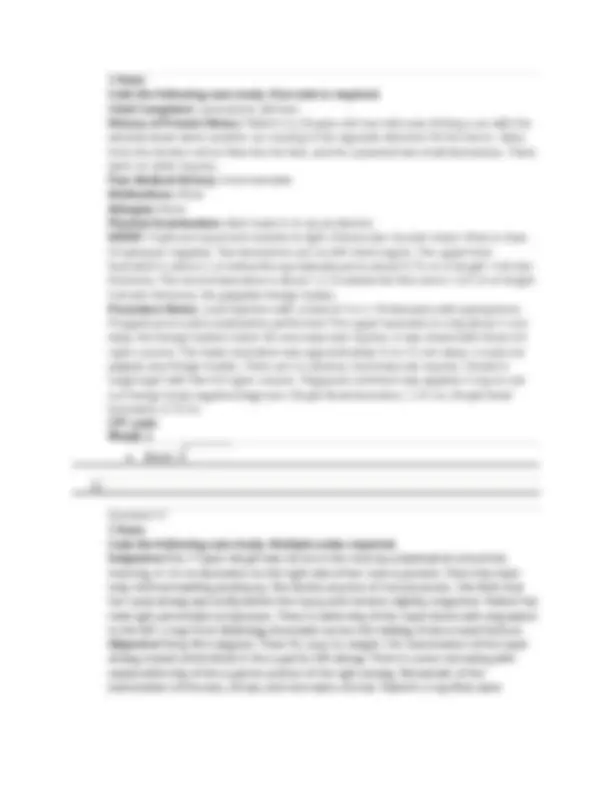
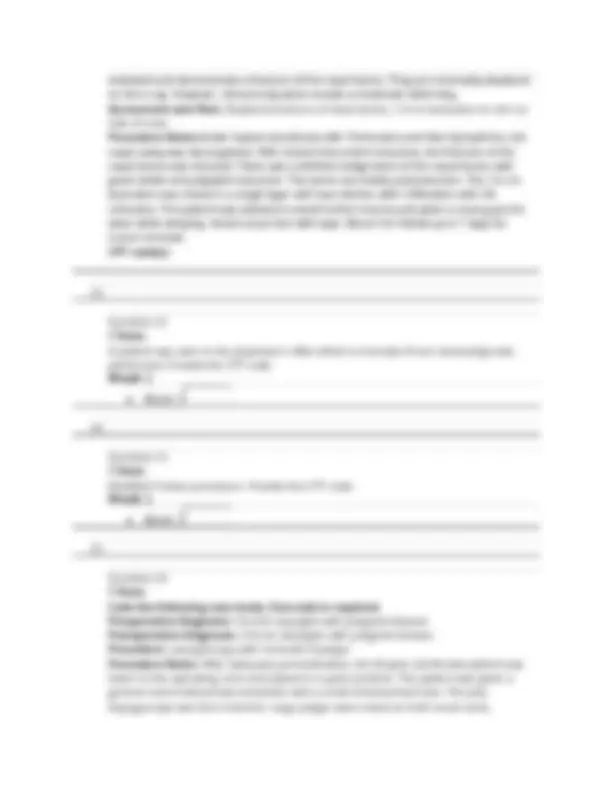
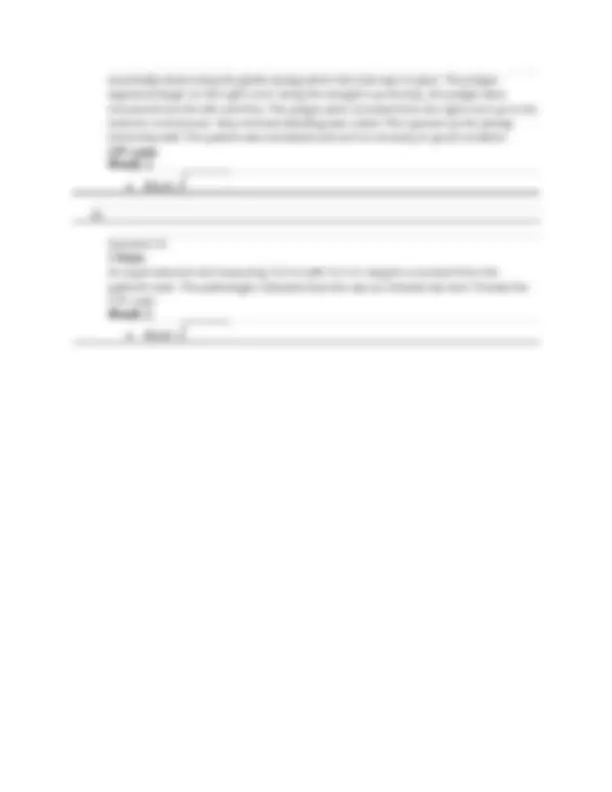


Study with the several resources on Docsity

Earn points by helping other students or get them with a premium plan


Prepare for your exams
Study with the several resources on Docsity

Earn points to download
Earn points by helping other students or get them with a premium plan
Community
Ask the community for help and clear up your study doubts
Discover the best universities in your country according to Docsity users
Free resources
Download our free guides on studying techniques, anxiety management strategies, and thesis advice from Docsity tutors
Module 03 Assignment - Coding from Medical Documentation Worksheet
Typology: Lab Reports
1 / 10

This page cannot be seen from the preview
Don't miss anything!







Student Instructions: This coding worksheet contains 25 questions. You can re- enter the worksheet unlimited times but submit only once. Please use coding resources to complete the following worksheet.
Question 1 1 Point Collection of blood specimen from an implanted central venous access device. Provide the CPT code: Blank 1 o Blank 1
Question 2 1 Point Removal of an implantable defibrillator pulse generator without replacement. Provide the CPT code: Blank 1 o Blank 1
Question 3 1 Point
Blalock-Taussig shunt placement. Provide the CPT code: Blank 1 o Blank 1
Question 4 1 Point Repair of nail bed, third digit left hand. Provide the CPT code: Blank 1 o Blank 1
Question 5 1 Point Blepharoplasty, left upper eyelid. Provide the CPT code: Blank 1 o Blank 1
Question 6 1 Point Percutaneous needle biopsy of left lung upper lobe. Provide the CPT code Blank 1 o Blank 1
Question 7 1 Point Upgrade of a single chamber cardiac pacemaker system to a dual chamber system. Provide the CPT code: Blank 1 o Blank 1
Question 8 1 Point Code the following case study. One code is required. Preoperative Diagnosis: Symptomatic third-degree heart block
homogenous in color at this time. They do not appear to be any larger than 6 mm in size. No treatment is done for these today. Assessment and Plan: Skin tag removal. Procedure Notes: Skin tag removal. These areas were cleansed with alcohol. Curved iris and pickups were used to snip the skin tags off at the base of the two skin tags around the neck. Triple antibiotic ointment and a bandage was placed over these. For the skin tag in the right upper/inner thigh, 2% Xylocaine without epinephrine was used for anesthesia. It did have a somewhat large base, but a curved iris and pickups were used to cut the skin tag off at the base and handheld electrocautery was used to control bleeding. Triple antibiotic ointment and a bandage was put over this. Multiple actinic keratoses were treated with liquid nitrogen. One keratosis on the chest, one keratosis on the back, one keratosis above the right ear, one keratosis above the left ear. Each were treated with liquid nitrogen. Complex nevi. I advised him that he should have these looked at every six months, and he will return for this. CPT code(s):
Question 10 1 Point Code the following case study. One code is required. Preoperative Diagnosis: Internal derangement left knee Postoperative Diagnosis: Tear of lateral meniscus Procedure: Left knee arthroscopy, partial meniscectomy Procedure Notes: The arthroscope was inserted through the routine superolateral portal as well as an inferomedial portal for insertion of scope and instruments. The knee joint was then examined in routine manner; the medial meniscus was intact. The lateral meniscus was partially detached, and this portion was removed. No other defects were noted. The knee was irrigated well using normal saline. The instruments were removed from the knee. Wound closed with #4-0 nylon and dressed. Estimated blood loss 0. Intravenous fluids 1,000 cc. Specimen: meniscus. CPT code: Blank 1 o Blank 1
Question 11 1 Point Code the following case study. One code is required. Preoperative Diagnosis: Dysphonia Postoperative Diagnosis: Dysphonia Procedure: Direct microlaryngoscopy under general anesthesia
Procedure Notes: A 40-year-old patient was taken to the OR where; under general a laryngoscope was inserted with the operating microscope to perform a laryngoscopy. The vocal cords were found to be totally normal on both sides with no evidence of nodules or granuloma formation. The entire endolarynx was well visualized. Moreover, there was no evidence of subglottic stenosis; and as the patient was awakening, vocal cord mobility appeared to be normal. The procedure was completed, and the patient awakened and was taken to the recovery room in good condition with stable vital signs. CPT code: Blank 1 o Blank 1
Question 12 1 Point Single layer closure of a 2.1 cm laceration on the right lower arm. Provide the CPT code: Blank 1 o Blank 1
Question 13 1 Point Code the following case study. Multiple codes required. Preoperative Diagnosis: Multiple lacerations to both ears Postoperative Diagnosis: Multiple lacerations to both ears, one laceration to the left ear and a series of four lacerations to the right ear Anesthetic: Local anesthetic was used. 1% Carbocaine Plain Indications: The patient sustained the above-named lacerations when she was involved in a hay wagon accident. Procedure Notes: The patient was treated in the emergency department. The right ear was treated first. There were a total of 4 lacerations on the right ear treated. The two smaller, more superficial lacerations, measuring 1.0 cm each were closed in a single layer after the wounds had been infiltrated with 1% carbocaine and then cleaned copiously with Betadine, saline, and peroxide. They were closed with simple interrupted #6-0 Prolene sutures. The two other lacerations on the right ear, totaling 3 cm in length (one laceration was 1.2 cm in length and the other laceration was 1.8 cm in length) were closed in multiple layers with #5-0 Vicryl suture after they had been infiltrated with 1% carbocaine prepared and draped in the appropriate fashion using Betadine, peroxide, and saline. The superficial layers were closed with interrupted #6-0 Prolene suture. After the right ear was completed the wounds were covered with polysporin. The 2.0 cm laceration on the left ear was then closed in a single layer. It was infiltrated with 1% carbocaine. After the wound was cleaned with Betadine, saline, and peroxide the
o Blank 1
Question 17 1 Point Code the following case study. One code is required. Preoperative Diagnosis : Dermal Cyst of right breast Postoperative Diagnosis: Dermal Cyst of right breast Procedure Performed: Excision of Dermal Cyst of right breast Procedure Notes: Erythematous dermal cystic area of the right breast was marked out with an elliptical incision, anesthetized with local anesthesia, and prepped and draped sterilely. Incision was made elliptically, including the whole cyst down through the fatty tissue. On palpation afterward, no abnormalities were noted. Then the area had hemostasis obtained with electrocautery. The incision was closed with interrupted 3- Vicryl sutures. The skin was closed with interrupted 5-0 nylon sutures. Steri-Strips and a sterile dressing were applied over it. The patient tolerated the procedure well and was sent to the recovery room with instructions to be discharged home with follow-up appointment given. CPT code: Blank 1 o Blank 1
Question 18 1 Point A child was brought to the physician’s office with a Lego stuck up her nose. The physician was able to remove it with forceps. Provide the CPT code: Blank 1 o Blank 1
Question 19 1 Point Puncture aspiration of cyst on left breast. Provide the CPT code Blank 1 o Blank 1
Question 20
1 Point Code the following case study. One code is required. Chief Complaint: Lacerations; left face History of Present Illness: Patient is a 26-year-old man who was driving a car with the window down when another car moving in the opposite direction hit his mirror. Glass from the broken mirror flew into his face, and he sustained two small lacerations. There were no other injuries. Past Medical History: Unremarkable Medications: None Allergies: None Physical Examination: Alert male in no acute distress HEENT: Pupils are equal and reactive to light. Extraocular muscles intact. Nose is clear. Oropharynx negative. Two lacerations are on left cheek region. The uppermost laceration is about 2 cm below the eye laterally and is about 0.75 cm in length. Full-skin thickness. The second laceration is about 1.5 cm below the first and is 1.25 cm in length. Full-skin thickness. No palpable foreign bodies. Procedure Notes: Local injection with a total of 3 cc's 1% lidocaine with epinephrine. Prepped and routine exploration performed. The upper laceration is only about 5 mm deep. No foreign bodies noted. No neurovascular injuries. It was closed with three 6- nylon sutures. The lower laceration was approximately 12 to 15 mm deep. I could not palpate any foreign bodies. There are no obvious neurovascular injuries. Closed in single layer with five 6-0 nylon sutures. Polysporin ointment was applied. X-ray to rule out foreign body negative.Diagnosis: Simple facial laceration, 1.25 cm, Simple facial laceration, 0.75 cm CPT code: Blank 1 o Blank 1
Question 21 1 Point Code the following case study. Multiple codes required. Subjective: This 17-year-old girl was struck in the nose by a baseball at school this morning. A 1.6 cm laceration on the right side of her nose is present. There has been only minimal swelling postinjury. She denies any loss of consciousness. She feels that her nasal airway was stuffy before the injury and remains slightly congested. Patient has mild right periorbital ecchymoses. There is deformity of the nasal bones with angulation to the left. x-rays from Radiology Associates across the hallway show a nasal fracture. Objective: Temp 98.4 degrees. Pulse 92, resp 22, weight 126. Examination of the nasal airway reveals dried blood in the superior left airway. There is some narrowing with septal deformity of the superior portion of the right airway. Remainder of the examination of the ears, throat, and neck were normal. Patient’s x-ray films were
essentially obstructing the glottic airway when the tube was in place. The polyps appeared larger on the right cord. Using the straight-cup forceps, the polyps were removed from the left cord first. The polyps were removed from the right cord up to the anterior commissure. Very minimal bleeding was noted. This opened up the airway extremely well. The patient was extubated and sent to recovery in good condition. CPT code: Blank 1 o Blank 1
Question 25 1 Point An asymmetrical nevi measuring 3.0 cm with 0.2 cm margins is excised from the patient’s back. The pathologist indicated that this was an intradermal nevi. Provide the CPT code: Blank 1 o Blank 1